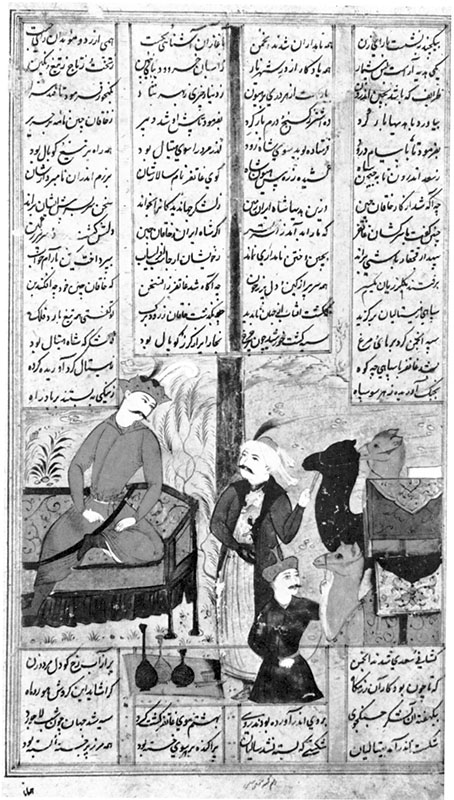Location: Nasser D. Khalili Collection of Islamic Art, London. Previously in the Kraus Collection, New York.
Page: 34.5 x 22.3 cm.
Painting: 12.2 cm. high x 15.0 cm. wide (after Grube)
Text area: 29.2 x 15.9 cm.(scaled)
Signature: in the lower margin, raqam-e kamina moʿin-e moṣavver. Not dated.
The accompanying text, isolated from its position in the manuscript, provides insufficient information to accurately identify the precise episode being depicted. Several names are mentioned — Ḵosrow, probably intended for Kay Ḵosrow; Arjāsp-e Afrāsiyāb, son of the Turånian king; the Ḵāqān of Chin; and Qātfar, a personage of uncertain identity. The text relates the arrival of a caravan of ten camels laden with exotic goods, and a message written on silk from the Ḵāqān, apparently an effort to sway Ḵosrow into making some type of agreement. Thus, it would appear that Grube's identification, The Spoils of the Battle with the Ḵāqān Brought to Ḵosrow, likely but not certain.
In the illustration, Ḵosrow is seated on a hexagonal shaped elevated throne on the left. He wears a crown adossed with feathers, a long robe, boots, and a sword hanging from his belt. His facial features are nearly identical to the Ḵosrow portrayed in 3_Ḵosrow and one might assume that they are intended to be the same personage. Ḵosrow gazes toward the center of the painting, in the direction of a turbanned man wearing a long robe and topcoat, who stands before him holding the reins of a camel. He would appear to be a merchant or emissary. Further to the foreground is another, less distinguished, personage who might be identified as a caravan driver. His clothing, which includes a flat-top cap with kolāh, is of the same style as abundantly represented in Moʿin’s Esmāʿil manuscripts (cf. mss. L, M, and N). Three of the ten camels mentioned in the text, laden with goods, can be seen on the right. The setting is only summarily suggested: some delicate foliage behind Ḵosrow, and a hilly landscape in the right background. A cloth, on which three decanters are placed, is spread on the ground at the base of the throne.
Painting references:
Grube, Kraus, no.167.
Text references:
Warner III, pp. 232-36.
Photo after Grube,
no.167
Robert Eng
Last Updated: July 5, 2015 | Originally published: July 5, 2015
